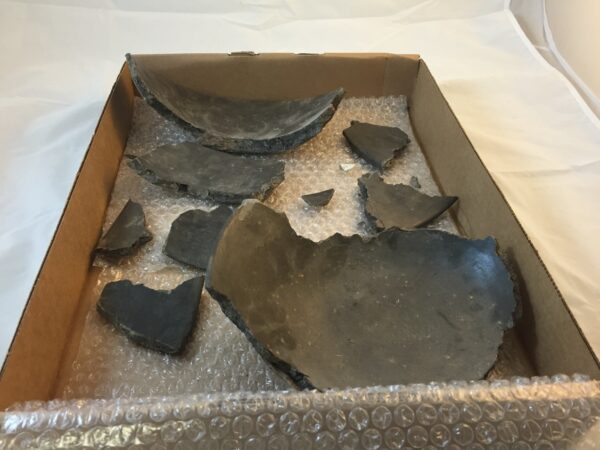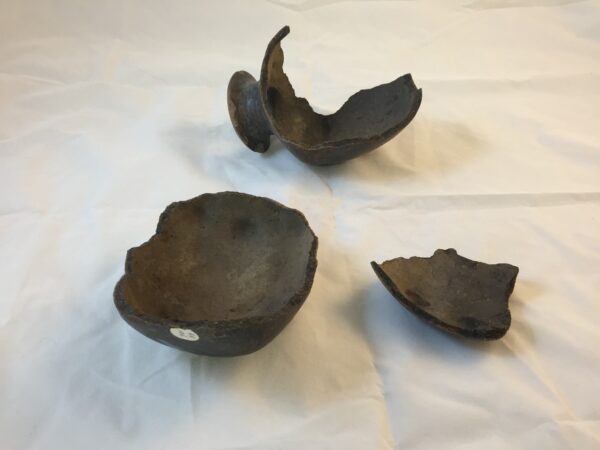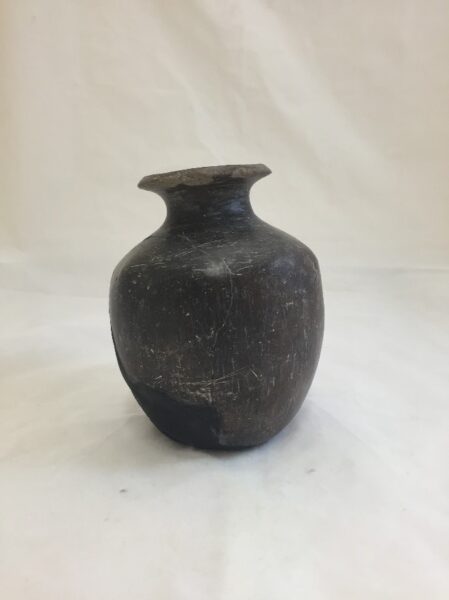The Lopsided Undecorated Ceramic Bowl and the Wobbly Ceramic Water Bottle were made by the Native American Mississippian cultures, who are well-known for their ceramic craftsmanship. Such vessels were made from local clays mixed with ground shell, which made the vessels stronger and more durable. As shown by the finger marks and scrapes visible on the interior of these vessels, they were hand-coiled and pinched into shape, and any rough areas were scraped smooth with a shell. The polished exterior surfaces were achieved by painting the surface with slip and then burnishing with a smooth stone.
Well-preserved Mississippian vessels such as these were likely used in burials. Although some funerary vessels were decorated with incision or sculpted into figures of people or animals, simpler vessels were filled with food or other offerings and placed next to or in the hands of the deceased. Some high-status burials of both men and women included many vessels as well as symbolic objects such as shell beads, tools, stone projectile points, and weapons. These burials were sometimes also covered with a large mound to serve as a marker and a memorial.

Lopsided Undecorated Ceramic Bowl
Mississippian cultures
Mississippian period
Clay with shell temper, smallest piece: L. 3.3 cm x W. 2.1 cm x H. 0.6 cm, largest piece: L. 21.6 cm x W. 14.8 cm x H. 7.5 cm
Ralph Foster Museum collection #76.1042.504

Lopsided Undecorated Ceramic Bowl
Mississippian cultures
Mississippian period (1000-ca.1550 CE)
Clay with shell temper
Smallest piece: L. 3.3 cm x W. 2.1 cm x H. 0.6 cm
Largest piece: L. 21.6 cm x W. 14.8 cm x H. 7.5 cm
Ralph Foster Museum collection #76.1042.504

Wobbly Ceramic Water Bottle
Mississippian cultures
Mississippian period
Clay with shell temper, smallest piece: L. 8.4 cm x W. 7 cm x H. 2.9 cm, largest piece: L. 14.8 cm x W. 9.1 cm x H. 9.3 cm
Ralph Foster Museum collection #76.790.9 HA/06

Wobbly Ceramic Water Bottle
Mississippian cultures
Mississippian period (1000-ca.1550 CE)
Clay with shell temper
Smallest piece: L. 8.4 cm x W. 7 cm x H. 2.9 cm
Largest piece: L. 14.8 cm x W. 9.1 cm x H. 9.3 cm
Ralph Foster Museum collection #76.790.9 HA/06
For more information, you may contact the researcher(s) noted in the title of this exhibit entry, or Dr. Billie Follensbee, the professor of the course, at BillieFollensbee@MissouriState.edu

